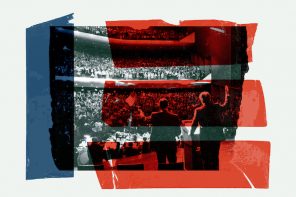Censorship of a gay Last Supper from an Austrian art show signals a troubling trend: America is exporting religious intolerance.
Some local visitors did complain about the art, but museum director Bernhard Boehler blames the artwork’s removal on “massive verbal hostility” from American religious blogs, which then spread to Europe. Fundamentalist blogs denounced it as “blasphemous,” “trash,” “sacrilege,” and “an abomination,” language harsh enough, according to Reuters, to prompt Austrian media to dub the controversy “Vienna’s version of the Mohammad caricature row.”
Protests sparked by American fundamentalists caused Vienna’s Roman Catholic Cathedral and Diocesan Museum to pull the main picture from a retrospective exhibit by Alfred Hrdlicka, a celebrated Austrian artist who turned 80 this year. After a week on display, the homoerotic “Last Supper” was taken down recently at the request of Austria’s Cardinal Christoph Schoenborn.
The hostility against gay Jesus art is all too familiar, but the Hrdlicka case seems to be the first where the American religious right managed to limit freedom of speech in other countries.
The recent Austrian controversy is the latest battle in an ongoing war over queer Christian art, some of the most dramatic cases of which are documented in my book, Art That Dares: Gay Jesus, Woman Christ, and More. The brave, visionary artists who portray the gay Jesus face censorship, hate mail, violence, death threats, and/or vandalism that destroy their work. Many are accused of blasphemy as religious freedom clashes with freedom of expression, with conservatives utilizing Christian rhetoric to justify hate, censorship and discrimination against gay, lesbian, bisexual, and transgender (GLBT) people [Watch an anti-Hrdlicka video here].
Until now the opposition to gay Jesus art has been almost exclusively homegrown. Local vandals in San Francisco smashed the image of “Jesus kissing the Hindu god Rama” by California artist Alex Donis; Swedish fundamentalists were the first to send death threats to Swedish photographer Elisabeth Ohlson Wallin after her photos of Jesus with contemporary LGBT people were shown in Stockholm; and so on. This time, however, although the explosion over gay Jesus art may have happened in Austria, the fuse was lit in America.
As a lesbian Christian author and minister I believe that Christ represents everybody, including those whose sexual preferences and practices often render them outcasts. I fear that American fundamentalism is beginning to spread outward, beyond US borders, in an effort to polarize even those precious spots where tolerance still permits genuine dialogue on religion and sexuality. America’s religious conservatives are abusing their freedom of speech to intimidate and impose their views on the whole world.
Lost in the fray is the deeper meaning of the art that tries to reconcile body and soul, sexuality and spirituality. Hrdlicka’s “Last Supper,” which the artist himself calls a “homosexual orgy,” celebrates the union of flesh and spirit—the same idea that Jesus embodied when he passed bread to his disciples and said, “This is my body” (Mark 14:22).
Hrdlicka, an atheist and anti-war activist who personally witnessed the effects of Nazism and violence, often employs biblical imagery, especially the suffering of Christ, a central theme in his art. The rest of his exhibit, titled “Religion, Flesh and Power,” remains on display until May 10 with two other controversial images: A sculpture of Jesus on the cross without a loincloth, and a crucifixion in which a soldier holds Jesus’ genitals while beating him.
Over the past 20 years, artists in many nations, working in isolation, began portraying the queer Christ—Hrdlicka among them. Traditional iconography such as the Stations of the Cross, the Man of Sorrows and the Passion narrative have all been adapted to address gay suffering; hurt and humiliation inflicted by homophobes becomes a universal metaphor for all human suffering.
The gay Jesus images may come as a shock, especially to those who believe in the divinity of Jesus Christ. Indeed, some denounce them as blasphemy because they differ from traditional images. Legally, blasphemy refers to speech that is designed to transgress or express contempt for central religious beliefs. One of the charges that led to Jesus’ crucifixion two thousand years ago was, ironically, the very same charge being leveled against Hrdlicka and other artists who dare to put Jesus in a gay context: blasphemy.
A growing number of people reject the narrowness of the blasphemy charge, instead experiencing the queer Jesus imagery as a blessing that enhances Christian faith by embodying God’s radically inclusive love for all. It is appropriate, even essential, for Christians to explore the gay side of Jesus because in him God became flesh—a total, shocking identification with all people, including the sexually marginalized.
My experiences as a minister and art historian have shown me that many people are longing for progressive spiritual perspectives, including images, as an alternative to the conservative monopoly over much of what is currently identified as Christian, including traditional imagery. People often try to censor or destroy art featuring the gay Jesus, as was the aforementioned case in Austria, but I am grateful to the artists who are pioneers on this sacred path of inclusiveness. Religious intolerance may be exported over the Internet, but so are the voices of freedom.




